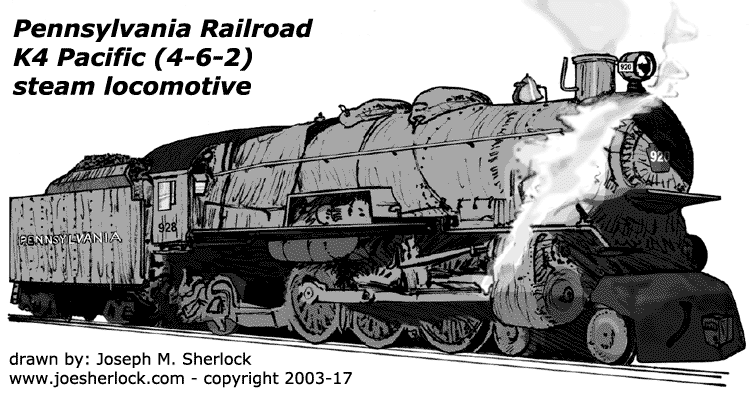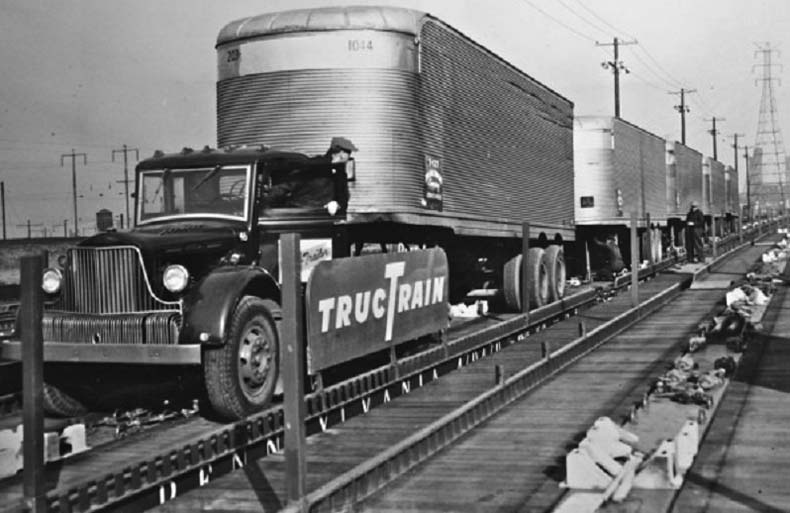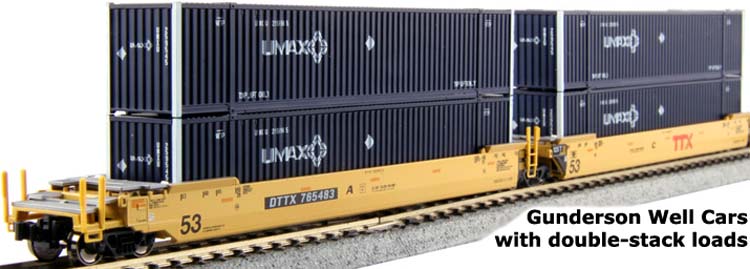A Select History Of U.S. Railroading

Once upon a time, U.S. railroads were the kings of transport. Railroads played a large role in the development of the United States from the industrial revolution to the settlement of the West.
In his book, 'Blood, Iron and Gold: How the Railroads Transformed the World', Christian Wolmar wrote, "The U.S. transcontinental railroad was made possible by Abraham Lincoln, who passed the Pacific Railroad Act through Congress in 1862 (in the midst of the Civil War), helped by the absence of southern politicians who had stymied previous attempts at legislation." The transcontinental road was greatly underwritten by the government using direct payments, loans and land grants.
U.S. railroads did more than just increase travel or expand local and national economies. Trains created a manufacturing industry from local cottage craft works, made perishables widely available and inspired the concept of 'vacations'. They truly changed the way human beings experienced life. The nationwide expansion of railroads ultimately caused time zones to be invented.
|
|
Alexander Mitchell's Consolidation locomotive was photographed outside the Baldwin Locomotive Works Philadelphia factory prior to delivery in July 1866. Mitchell was master mechanic of the Lehigh and Mahoney Railroad. He needed a powerful engine to pull coal loads over steep grades and the 2-8-0 design was such a great success that Baldwin soon incorporated the Consolidation in its line of offerings. In 1875, the PRR made it the railroad's standard freight locomotive. Total U.S. production of the Consolidation class has been estimated at more than 33,000 locomotives.
|
The importance of railroads in the 19th and early 20th Centuries cannot be overstated. By 1900, railroads were the stock market, accounting for 63% of the value of listed U.S. stocks.
America is a land of change and, when markets evolve or there is technological transformation, industrial icons sometimes can't adapt - they wither and disappear. Economist Joseph Schumpeter has pointed out that creative destruction is an integral part of free-market capitalism, where newer technologies and more efficient methods kill off older, traditional businesses, even if they are beloved by small groups of enthusiasts.
That's what happened to traditional railroading; the decline of the Pennsylvania Railroad exemplifies how technical progress adversely affected this mighty transportation giant.
Established in 1846 at the dawn of U.S. railroads, the Pennsylvania Railroad was the largest railroad by traffic and revenue in the U.S. for the first half of the 20th century. Over the years, it acquired, merged with or owned part of at least 800 other rail lines and companies. At the end of 1925, it operated 10,515 miles of rail line.
At one time, the PRR was the largest publicly-traded corporation in the world, with a budget larger than that of the U.S. government and a workforce of about 250,000 people. My dad, four of his siblings and my paternal grandfather worked for the Pennsy, as did some of my cousins.
The Pennsylvania Railroad suffered from declining financial health in its later years. Passenger operations never contributed much to profits and the Pennsy never made a dime on passenger service after 1946. Passenger trains were killed off by better highways which made automobile travel more practical for distances up to 300 miles and by air travel, especially after jet airplanes became commonplace.
|
|
|
This PRR Class X29L steel boxcar was built in the 1920s. Displayed the Railroaders' Memorial Museum in Altoona, PA.
|
Freight revenues declined too, particularly after the proliferation of Interstate highways facilitated fast delivery of goods by truck. LCL (less-than-carload) shipments by rail peaked at 50 million tons in 1919; by 1958, it had declined to 4 million tons. Trucks were faster and more cost-effective for trips of two days or less, especially for LCL shipments. Railroads are most efficient in moving large quantities of product over long distances. In the 1950s, the profitable Union Pacific had an average freight haul of 600 miles, compared to only 244 miles for the Pennsylvania Railroad.

Like many of its northeastern railroading brothers (Reading, Norfolk & Western, Jersey Central, Lehigh Valley), the Pennsylvania Railroad made much of its freight revenue hauling coal. In the early 20th Century, nearly every mill and factory, every steam locomotive as well as most home furnaces burned coal. Anthracite usage peaked in 1914 and, except for upticks in demand during the World Wars I and II, coal usage steadily declined. Oil-burning diesel locomotives replaced coal-burning steam locos, home furnaces were converted to heating oil or natural gas and industrial demand dropped due to conversion to other energy sources and the general industrial decline in the Northeastern U.S. as companies relocated in search of lower-cost labor. The sharp decline in coal shipments severely cut into the profitability of many N.E. railroads, the Pennsy included.
In the 1960s, PRR management attempted to diversify into more profitable markets - investments in commercial real estate, theme parks, oil producers and even acquiring Strick, a manufacturer of truck trailers. But it was too little, too late.
By the time they merged in 1968, the Pennsylvania Railroad, New York Central and New Haven were all on the ropes. The merger was a marriage of desperation. And it never worked because each participating company had different cultures, values and equipment. The merged entity fought with itself all the time. Penn Central Railroad entity declared bankruptcy in June of 1970.
In 1971, quasi-government entity Amtrak took over Penn Central's passenger service. Railroad historian and former transport reporter Don Phillips wrote in Classic Trains magazine (Summer 2016 issue), "Amtrak came into being on May 1, 1971, as a means of relieving the Northeastern railroads - particularly Penn Central, the nation's biggest intercity passenger carrier - of heavy losses ... it was widely assumed that Amtrak would go away within two or three years." Any government-supported bureaucratic organization is almost eternal in nature - it just won't die and politicians refuse to kill it. And so Amtrak lingers on as a money-losing national carrier 46 years after its creation as a 'temporary' agency.
In April, 1976, Conrail was formed as a for-profit freight railroad. Owners were the creditors of the seven bankrupt railroads within Conrail - Penn Central, Erie-Lackawanna, Reading and others.
|
|
1999: The author at Frankford Junction in Philadelphia with Conrail diesel locomotive in the background - his dad used to work out of Frankford Junction for the Pennsylvania Railroad (later Penn Central, then Conrail). Frankford Junction is where the Northeast Corridor line from Trenton connects with the 2-track Atlantic City line. The junction, located in near the Kensington and Port Richmond sections of town, has a freight switching yard known as Frankford Yard. Rails have been at/near the junction since the 1830s.
|
Conrail eventually became profitable by dumping unprofitable routes and services. In 1999, Conrail was split in two - half went to CSX (Chessie); half went to Norfolk Southern.
Almost all large U.S. railroads now focus on long-mileage, point-to-point haulage of carload lots of merchandise. They leave the shorter routes, smaller shipments and intracity delivery to the truckers.

Double-stack rail transport (where intermodal containers are stacked two high on railroad cars) now accounts for about 70% of U.S. intermodal shipments. Double-stack technology permits a freight train of a given length can carry roughly twice as many containers, sharply reducing shipping costs. Well-cars - a special freight car - reduce load height (permitting trains to use conventional tunnels and underpasses) and lowers the center of gravity of a loaded car for better stability. In addition, the well-car design significantly reduces damage in transit and provides greater cargo security by cradling the lower containers so their doors cannot be opened.
Employment at major U.S. railroads plummeted from 1.35 million in 1947 to 152,000 in 2016. But because of greater efficiency and a laser-like focus on profitability of freight operations, U.S. railroads are profitable and thriving.
In the book 'Big Money Thinks Small: Biases, Blind Spots, and Smarter Investing', Joel Tillinghast wrote, "With diesel locomotives and double-stacked containers, railroads move almost three times the ton-miles at higher speeds by fewer employees on less track. Behind the scenes, routing, scheduling safety, and track maintenance have been automated and computerized."
In 1964, the operating profit margin of the Pennsylvania Railroad and New York Central averaged 27%. Fifty years later, their successor company, Norfolk Southern produced a 31% OPM. (posted 10/16/17)
Other Pages Of Interest
| blog: 'The View Through The Windshield' |
| greatest hits: index of essays & articles | blog archives | '39 Plymouth |
| model train layout | about me | about the blog | e-mail |
copyright 2017-21 - Joseph M. Sherlock - All applicable rights reserved
Disclaimer
The facts presented on this website are based on my best guesses and my substantially faulty geezer memory. The opinions expressed herein are strictly those of the author and are protected by the U.S. Constitution. Probably.
Spelling, punctuation and syntax errors are cheerfully repaired when I find them; grudgingly fixed when you do.
If I have slandered any brands of automobiles, either expressly or inadvertently, they're most likely crap cars and deserve it. Automobile manufacturers should be aware that they always have the option of trying to change my mind by providing me with vehicles to test drive.
If I have slandered any people or corporations, either expressly or inadvertently, they should buy me strong drinks (and an expensive meal) and try to prove to me that they're not the jerks I've portrayed them to be. If you're buying, I'm willing to listen.
Don't be shy - try a bribe. It might help.
|
|